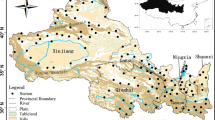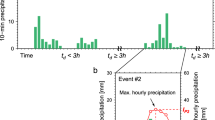Abstract
Observations unequivocally show that Iran has been rapidly warming over recent decades, which in sequence has triggered a wide range of climatic impacts. Meteorological records of several ground stations across Iran with daily temporal resolution for the period 1951–2013 were analyzed to investigate the climate change and its impact on some weather extremes. Iran has warmed by nearly 1.3 \(^{\circ }\)C during the period 1951–2013 (+0.2 \(^{\circ }\)C per decade), with an increase of the minimum temperature at a rate two times that of the maximum. Consequently, an increase in the frequency of heat extremes and a decrease in the frequency of cold extremes have been observed. The annual precipitation has decreased by 8 mm per decade, causing an expansion of Iran’s dry zones. Previous studies have pointed out that warming is generally associated with more frequent heavy precipitation because a warmer air can hold more moisture. Nevertheless, warming in Iran has been associated with more frequent light precipitation, but less frequent moderate, heavy and extremely heavy precipitation. This is because in the subtropical dry zones, a longer time is required to recharge the atmosphere with water vapour in a warmer climate, causing more water vapour to be transported from the subtropics to high latitudes before precipitations forms. In addition, the altitude of the condensation level increases in a warmer climate in subtropical regions, causing an overall decrease of precipitation. We argue that changing in the frequency of heavy precipitation in response to warming varies depending on the geographical location. Warming over the dry subtropical regions is associated with a decrease in the frequency of heavy precipitation, while an increase is expected over both subpolar and tropical regions. The warmer climate has also led to the increase in the frequency of both thunderstorms (driven by convective heating) and dust events over Iran.








Similar content being viewed by others
References
Alexander LV, Zhang X, Peterson TC, Caesar J, Gleason B, Tank AMGK, Haylock M, Collins D, Trewin B, Rahimzadeh F, Tagipour A, Kumar KR, Revadekar J, Griffiths G, Vincent L, Stephenson DB, Burn J, Aguilar E, Brunet M, Taylor M, New M, Zhai P, Rusticucci M, Vazquez-Aguirre JL (2006) Global observed changes in daily climate extremes of temperature and precipitation. J Geophys Res 111(D05):109
Alizadeh-Choobari O, Ghafarian P, Adibi P (2016a) Interannual variations and trends of the urban warming in Tehran. Atmos Res 170:176–185. doi:10.1016/j.atmosres.2015.12.001
Alizadeh-Choobari O, Ghafarian P, Owlad E (2016b) Temporal variations in the frequency and concentration of dust events over Iran based on surface observations. Int J Climatol 36:2050–2062. doi:10.1002/joc.4479
Alpert P, Kishcha P, Kaufman YJ, Schwarzbard R (2005) Global dimming or local dimming?: effect of urbanization on sunlight availability. Geophy Res Lett 32(L17):802
Argüeso D, Evans JP, Fita L, Bormann KJ (2014) Temperature response to future urbanization and climate change. Clim Dyn 42(7):2183–2199. doi:10.1007/s00382-013-1789-6
Byrne MP, O’Gorman PA (2015) The response of precipitation minus evapotranspiration to climate warming: why the “wet-get-wetter, dry-get-drier” scaling does not hold over land. J Clim 28:8078–8092
Chen JL, Wilson CR, Tapley BD (2013) Contribution of ice sheet and mountain glacier melt to recent sea level rise. Nat Geosci 6:549–552. doi:10.1038/ngeo1829
Childs PP, Raman S (2005) Observations and numerical simulations of urban heat island and sea breeze circulations over New York city. Pure Appl Geophys 162:1955–1980. doi:10.1007/s00024-005-2700-0
Coumou D, Rahmstorf S (2012) A decade of weather extremes. Nat Clim Change 2:491–496. doi:10.1038/nclimate1452
Donat MG, Peterson TC, Brunet M, King AD, Almazroui M, Kolli RK, Boucherf D, AlMulla AY, Nour AY, Aly AA, Nada TAA, Semawi MM, Al Dashti HA, Salhab TG, El Fadli KI, Muftah MK, Dah Eida S, Badi W, Driouech F, El Rhaz K, Abubaker MJY, Ghulam AS, Erayah AS, Mansour MB, Alabdouli WO, Al Dhanhani JS, Al Shekaili MN (2014) Changes in extreme temperature and precipitation in the Arab region: longterm trends and variability related to ENSO and NAO. Int J Climatol 34:581–592
Evans JP (2009) 21st century climate change in the Middle East. Climatic Change 92:417–432. doi:10.1007/s10584-008-9438-5
Fu Q, Johanson CM, Wallace JM, Reichler T (2006) Enhanced mid-latitude tropospheric warming in satellite measurements. Science 312:1179–1179
Goudie A, Middelton N (2006) Desert dust in the global system. Springer, Heidelberg, Germany
Grimm AM, Tedeschi RG (2009) ENSO and extreme rainfall events in South America. J Clim 22:1589–1609
Groisman PY, Knight RW, Easterling DR, Karl TR (2005) Trends in intense precipitation in the climate record. J Clim 18:1326–1350
Hanna E, Huybrechts P, Steffen K, Cappelen J, Huff R, Shuman C, Irvine-Fynn T, Wise S, Griffiths M (2008) Increased runoff from melt from the Greenland ice sheet: a response to global warming. J Clim 21:331–341
Huber M, Knutti R (2012) Anthropogenic and natural warming inferred from changes in Earth’s energy balance. Nat Geosci 5:31–36. doi:10.1038/ngeo1327
Hulme M (2014) Attributing weather extremes to ‘climate change’: a review. Prog Phys Geogr 38(4):499–511. doi:10.1177/0309133314538644
Huybrechts P, Letreguilly A, Reeh N (1991) The Greenland ice sheet and greenhouse warming. Global Planet Change 3:399–412
IPCC (2013) Climate change 2013: the physical science basis exit EPA disclaimer. contribution of working groups I, II and III to the fifth assessment report of the Intergovernmental Panel on Climate Change. In: Stocker TF, Qin D, Plattner GK, Tignor M, Allen SK, Boschung J, Nauels A, Xia Y, Bex V, Midgley PM (eds) Cambridge Univ. Press, Cambridge, UK and New York, NY, USA
Ishii M, Shouji A, Sugimoto S, Matsumoto T (2005) Objective analyses of sea-surface temperature and marine meteorological variables for the 20th century using ICOADS and the Kobe collection. Int J Climatol 25:865–879
Iyigun C, Türkes M, Batmaz I, Yozgatligil C, Purutcuoglu V, Koc EK, Öztürk MZ (2013) Clustering current climate regions of Turkey by using a multivariate statistical method. Theor Appl Climatol 114:95–106. doi:10.1007/s00704-012-0823-7
Kalnay E, Cai M, Li H, Tobin J (2006) Estimation of the impact of land-surface forcings on temperature trends in eastern United States. J Geophys Res 111(D06):106. doi:10.1029/2005JD006555
Karl TR, Kukla G, Gavin J (1984) Decreasing diurnal temperature range in the United States and Canada from 1941 through 1980. J Clim Appl Meteor 23:1489–1504
Karl TR, Jones PD, Knight RW, Kukla G (1993) A new perspective on recent global warming: asymmetric trends of daily maximum and minimum temperature. Bull Am Meteor Soc 74:1007–1023
Katz RW, Brown BG (1992) Extreme events in a changing climate: variability is more important than averages. Climatic Change 21:289–302
Knowles N, Dettinger MD, Cayan DR (2006) Trends in snowfall versus rainfall in the western United States. J Clim 19:4545–4559
Kusaka H, Kimura F (2004) Coupling a single-layer urban canopy model with a simple atmospheric model: impact on urban heat island simulation for an idealized case. J Meteor Soc Jpn 82:67–80
Lucas C, Timbal B, Nguyen H (2014) The expanding tropics: a critical assessment of the observational and modeling studies. WIREs Climate Change 5:89–112
McCarthy MP, Best MJ, Betts RA (2010) Climate change in cities due to global warming and urban effects. Geophys Res Lett 37(L09):705. doi:10.1029/2010GL042845
Mote PW (2003) Trends in snow water equivalent in the Pacific Northwest and their climatic causes. Geophys Res Lett 30:1601. doi:10.1029/2003GL017258
National Climatic Data Center (2011) U.s. Climate Extremes Index, National Oceanic and Atmospheric Administration. Retrieved November 22, 2011. http://1.usa.gov/vAH4Qx
Nicholls N (2004) The changing nature of Australian droughts. Climatic Change 63:323–336
O’Gorman PA (2015) Precipitation extreme under climate change. Curr Clim Change Rep 1:49–59. doi:10.1007/s40641-015-0009-3
Olea RA, Pawlowsky-Glahn V (2009) Kolmogorov–Smirnov test for spatially correlated data. Stochastic Environ Res Risk Assess 23:749–757
Philipona R, Dürr B (2004) Greenhouse forcing outweighs decreasing solar radiation driving rapid temperature rise over land. Geophys Res Lett 31(L22):208
Previdi M, Liepert BG (2007) Annular modes and Hadley cell expansion under global warming. Geophys Res Lett 34(L22):701
Reyes-Fox M, Steltzer H, Trlica MJ, McMaster GS, Andales AA, LeCain DR, Morgan JA (2014) Elevated CO2 further lengthens growing season under warming conditions. Nature 510:259–262
Sachs J, Stege M, Keju T (2009) Recent movements of the ITCZ in the tropical Pacific and ramifications for the Marshall Islands. IOP Conference Series: Earth Environ Sci 6:072,010
Santer BD, Wigley TML, Simmons AJ, Kållberg PW, Kelly GA, Uppala SM, Ammann C, Boyle JS, Brüggemann W, Doutriaux C, Fiorino M, Mears C, Meehl GA, Sausen R, Taylor KE, Washington WM, Wehner MF, Wentz FJ (2004) Identification of anthropogenic climate change using a second-generation reanalysis. J Geophys Res 109(D21):104
Sayari N, Bannayan M, Alizadeh A, Farid A (2013) Using drought indices to assess climate change impacts on drought conditions in the northeast of Iran (case study: Kashafrood basin). Meteorol Appl 20:115–127
Schär C, Vidale PL, Lüthi D, Frei C, Häberli C, Liniger MA, Appenzeller C (2004) The role of increasing temperature variability in European summer heatwaves. Nature 427:332–336. doi:10.1038/nature02300
Smith TM, Reynolds RW (2005) A global merged land-air-sea surface temperature reconstruction based on historical observations (1880–1997). J Clim 18:2021–2036
Stephens GL, Ellis TD (2008) Controls of global-mean precipitation increases in global warming GCM experiments. J Clim 21(23):6141–6155. doi:10.1175/2008JCLI2144.1
Stone RS, Dutton EG, Harris JM, Longenecker D (2002) Earlier spring snowmelt in northern Alaska as an indicator of climate change. J Geophys Res 107(D10):4089
Trenberth K, Jones P, Ambenje P, Bojariu R, Easterling D, Klein Tank A, Parker D, Rahimzadeh F, Renwick J, Rusticucci M, B S, Zhai P (2007) Observations: Surface and Atmospheric Climate Change. In: Climate Change 2007: The Physical Science Basis. Contribution of Working Group I to the Fourth Assessment Report of the Intergovernmental Panel on Climate Change. In: Solomon S, Qin D, Manning M, Chen Z, Marquis M, Averyt KB, Tignor M, Miller HL (eds). Cambridge University Press, Cambridge, UK, New York, NY, USA
Trenberth KE (2011) Changes in precipitation with climate change. Clim Res 47:123–138. doi:10.3354/cr00953
Wang XL, Swail VR, Zwiers FW (2006) Climatology and changes of extratropical cyclone activity: comparison of ERA-40 with NCEP-NCAR reanalysis for 1958–2001. J Clim 19:3145–3166
Ward JH (1963) Hierarchical grouping to optimize an objective function. J Am Stat Assoc 58:236–244
Acknowledgements
The financial support of the University of Tehran for this research under the Grant number 30449/1/03 is acknowledged.
Author information
Authors and Affiliations
Corresponding author
Rights and permissions
About this article
Cite this article
Alizadeh-Choobari, O., Najafi, M.S. Extreme weather events in Iran under a changing climate. Clim Dyn 50, 249–260 (2018). https://doi.org/10.1007/s00382-017-3602-4
Received:
Accepted:
Published:
Issue Date:
DOI: https://doi.org/10.1007/s00382-017-3602-4




